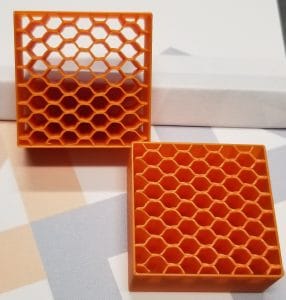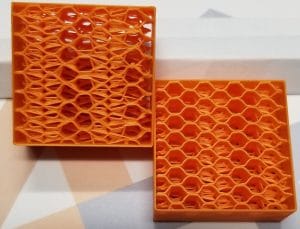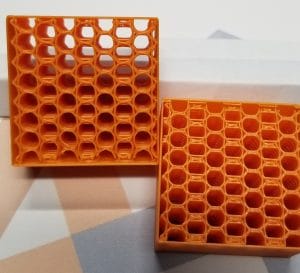Exotic Infill Styles via Insight!
Infill styles for FDM (Fused Deposition Modeling) rarely come up and that’s because there’s not much to talk about, right? Wrong!
 Sure, in GrabCAD Print we have the classics: Sparse, Sparse Double Dense, Hexagram, High Density, and Solid. They each have their uses and most people know what they do, but are those your only five options? Not even close.
Sure, in GrabCAD Print we have the classics: Sparse, Sparse Double Dense, Hexagram, High Density, and Solid. They each have their uses and most people know what they do, but are those your only five options? Not even close.
With the Insight software (available on F370 and Fortus 3D Printers from Stratasys) you can use a much larger variety of infill types and easily set different ones within the same part. This gives you further control over the performance, look, feel, and material consumption across different sections of your part.
Here is the available list from Insight:
-
Alternating Rasters (That’s Sparse’s alter ego)
-
Sparse – Double Dense
-
Hexagram
-
Hexagonal
-
Porous Hexagonal
-
Sawtooth
-
Permeable Triangle
-
Permeable Tubular
-
Gyroid
-
Schwarz D
Excluding the ones available in GrabCAD Print, lets take a closer look.

Hexagonal
Hexagonal is a great infill style giving good strength all-around while also being quick to print. Definitely no extended print times like hexagram with this one. It looks like honeycomb core many industries use for structural strength so you can try it with confidence!
Porous Hexagonal, Permeable Triangle, Permeable Tubular



I’m going to talk about these all together because they’re similarly designed.
Porous Hexagonal (left) is essentially a stacked pattern of groups of layers that form a hexagon pattern with some other patterns in between. These groups are also staggered.
The Permeable Triangle (center) is essentially a hexagram pattern but each layer is offset in the X and Y directions.
Permeable Tubular (right) is another stacked and rotating pattern that forms round “tubes” within the infill.
The reason that these are similar, is because none of them prevent sealed pockets within the infill. This means that water, cleaning solution, or whatever you need can flow throughout the inside easily. This is especially important if you’re printing something to be used as a core for a process like carbon fiber layup where you’ll then need to dissolve away the internal material. For the general user, it could help prevent prolonged water logged parts if you have to leave them in the wash tank for an extended period of time due to easier draining.

Sawtooth
Sawtooth is a strange beast where it creates a pattern resembling sparse but with a draw style like hexagonal. The different infill lines can easily separate because of their small points of contact and this style can be weak in the diagonal. You may find a use for this but I’d suggest just using either a sparse style or hexagonal if strength is a concern.
Gyroid and Schwarz D


I’m going to group these similar types again. They are really cool options and offer great strength and printability. They’re like a sparse with a twist (or squiggle) with an added offset pattern for gyroid.
Gyroid (left) has stacked diagonal waves in groups of a few layers that are gently offset and then rotated 90 degrees.
Schwarz D (right) looks like a sparse on some layers with straight, parallel rasters and the layers before and after are in the same direction although slightly wavy. When this pattern is repeated and rotated, you get great strength performance while maintaining print speed.
Hope this was intriguing, look at our other blog articles for a ton more information on 3D printing and CAD tips!
Nathan Fears
Application Engineer, Manufacturing Solutions
Computer Aided Technology, Inc.

 Blog
Blog